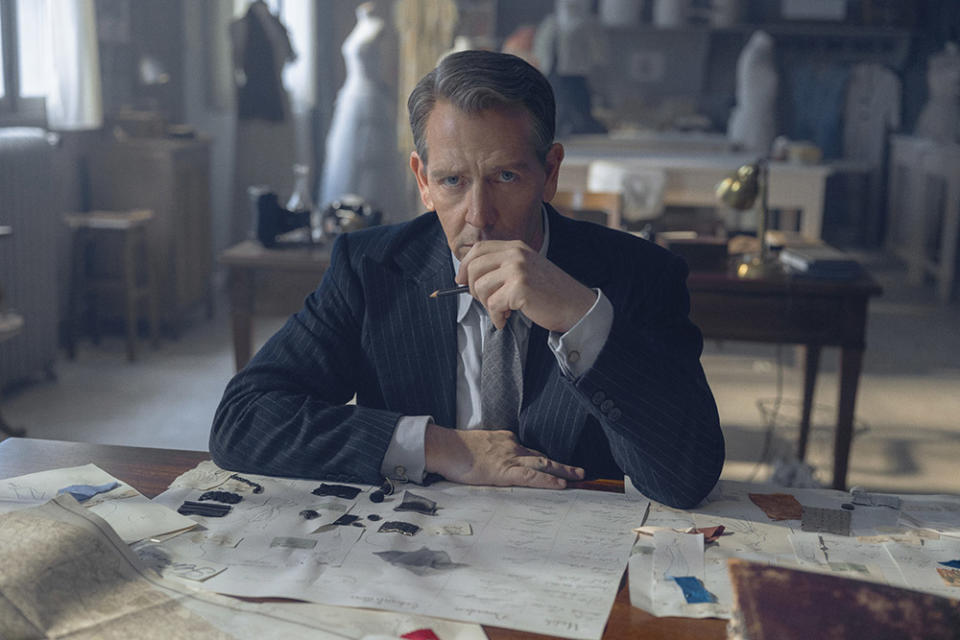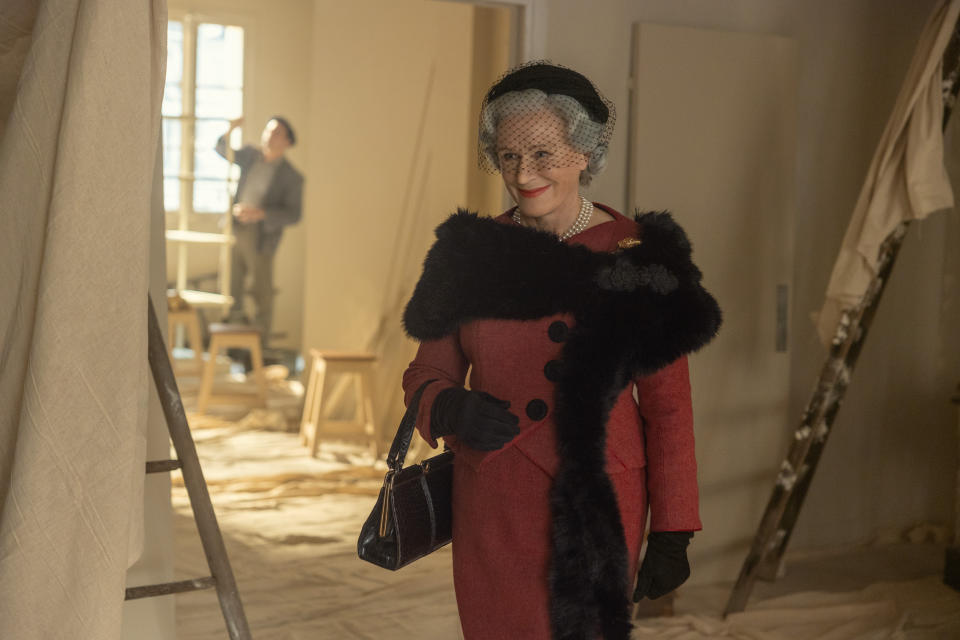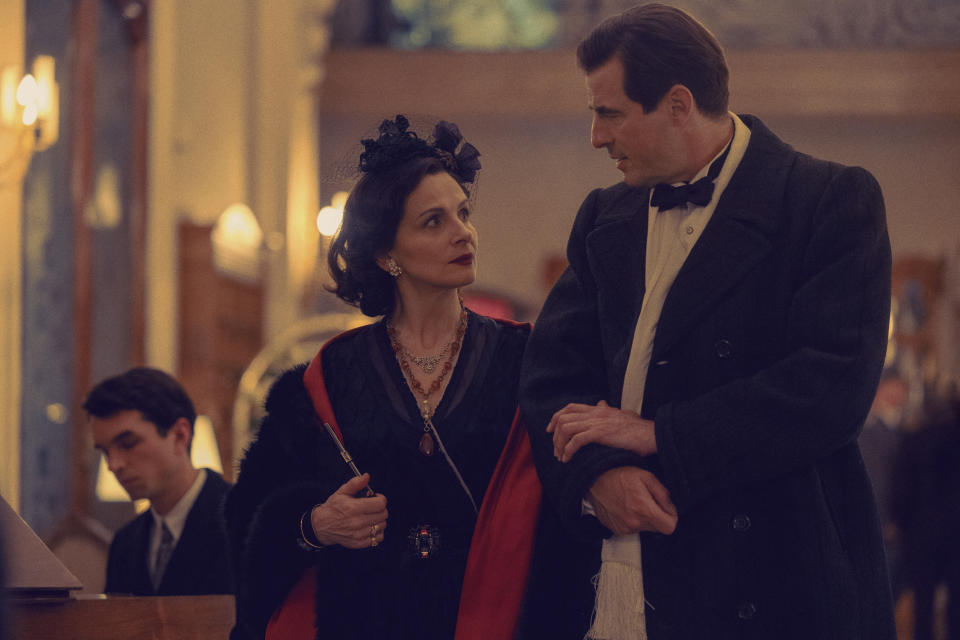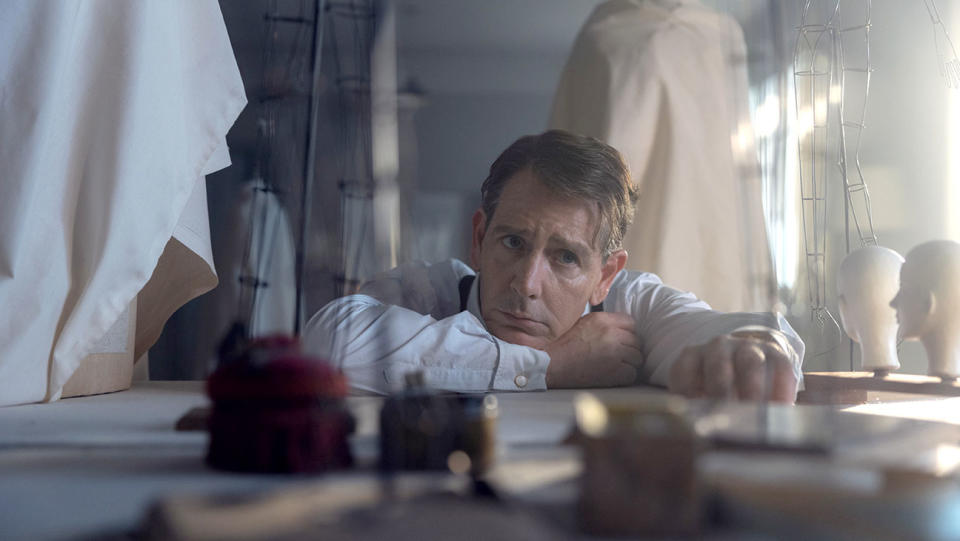‘New Look’ Boss Explains World War II Focus for Fashion-Centric Series
- Oops!Something went wrong.Please try again later.
- Oops!Something went wrong.Please try again later.
- Oops!Something went wrong.Please try again later.
- Oops!Something went wrong.Please try again later.
- Oops!Something went wrong.Please try again later.
- Oops!Something went wrong.Please try again later.

[The following story contains spoilers from the first four episodes of Apple TV+’s The New Look.]
The New Look not only marks creator Todd A. Kessler’s first series for Apple TV+, but it’s also his first project in years without his previous writing partners, his brother Glenn and collaborator Daniel Zelman, with whom Kessler co-created Damages and Bloodline.
More from The Hollywood Reporter
'The New Look' Boss Says Finale Isn't the End for Dior, Reveals Potential Season 2 Plans and Beyond
Elisabeth Moss, Kerry Washington to Star in 'Imperfect Women' for Apple
Instead, Kessler has partnered with veteran film producer Lorenzo Di Bonaventura, through their dB-AK production company, on the series about how Christian Dior, Coco Chanel and other French fashion designers of the time dealt with the struggles of World War II and launched modern fashion. The name refers to how Harper’s Bazaar editor-in-chief Carmel Snow described Dior’s 1947 collection.
Speaking to The Hollywood Reporter recently, both Kessler and Di Bonaventura were enthusiastic about their new professional pairing. When asked how working on this series was different than his previous endeavors, Kessler was quick to offer praise.
“It was amazing in that we had even greater ambition than Damages or Bloodline,” Kessler said of working on The New Look. “Bloodline was on location in the Florida Keys, which had its challenges, because there hadn’t been a production there. And for me and Lorenzo heading into this one, to film entirely in Paris, to recreate a time period, to have a story based on real people, to try to get the fashion right was a huge ambition. And based on Lorenzo’s experience in producing and being involved with over 170 movies and having a true sense of how to bring scope and scale to production, there’s no one I would rather have done this with.”
For his part, Di Bonaventura, who had been friends with Kessler for many years before they joined forces on The New Look, says, “from a creative point of view, this is the most exciting thing I’ve worked on.” He and Kessler first met more than 15 years ago working on a “script together for a film that ended up not getting made,” he says.
“We became really close friends and over the years we’ve gotten closer and closer,” Di Bonaventura tells THR. “He had been working with two other creators and that had ended. And I was dabbling, sometimes more times than others, in the TV space, and I wanted to get more involved. We were sitting at lunch one day going, ‘Why aren’t we working together?’ It was literally that kind of moment. What I find in film is, unfortunately, I don’t find the subject matter that we’re tackling all that interesting. It is not daring as an art form anymore, or I will say rarely, and television is where that’s happening. So the two of us have a lot of similarities in tastes and also we come from different points of view on these things, so it’s a really fantastic partnership.”
Kessler has reunited with a number of past collaborators on the fashion-centric series, including Bloodline actor Ben Mendelsohn, who plays Dior; Damages star Glenn Close, who plays Snow; and even Apple TV+ execs Jamie Erlicht and Zack Van Amburg, whom Kessler worked with when the pair were at Sony Pictures Television, which produced both Damages and Bloodline.
“I knew that I wanted to work with them again, and they happened to be at Apple,” Kessler says. “But it starts with the individuals and the relationships, and, having done eight seasons previously with Jamie and Zack, to bring them to this story I felt would be an experience that would continue to build on our relationship and deepen it.”
Di Bonaventura also appreciates the pair’s “open-mindedness” towards the series.
“This is not a straight down the middle idea, so it required some free thinking on their part,” he says. “The way they expressed themselves of why this was of interest was a lot of open-mindedness that gave a lot of room, particularly for Todd, in terms of letting his creativity flourish.”
And like with Erlicht and Van Amburg, Kessler’s connections with Mendelsohn and Close were key as he was setting up the series. Mendelsohn first sparked to the idea several years ago, after he’d done Bloodline with Kessler, when Kessler was making pizza at his home and was telling Mendelsohn about Dior.
“He said he’d read the autobiography of Christian Dior and then he said [Dior] had this real thing about his authentic private self and his public self, and [Dior] hated the fact that he couldn’t be his authentic self. [Dior] had a real problem with it and a lot of self-loathing around it,” Mendelsohn recalls. “And I said ‘Oh, when do we do it? When can we do it?'”

With Close, Kessler says she had visited him and his newborn son.
“I mentioned the character of Carmel Snow to her, just because we had spent several years researching. And she really sparked to the idea,” Kessler says. “So it was a very straight line when the opportunity arose for that character to be in the series, to be able to call Glenn and ask her if she would like to do it.”
And he jokes about the Emmy-winning Damages star, “If Glenn wanted to play Christian Dior, she would have been Christian Dior. The opportunity to work with Glenn on anything is a life experience to be cherished. She brings just so much inspiration for everyone that works with her. And so it was very gratifying personally to have another opportunity and also to be in Paris with her.”

Despite his past work with Kessler on Bloodline, Mendelsohn says his experience on The New Look was “completely different.”
“It was such a different shoot than Bloodline, it’s hard to imagine a kind of further apart polarity in a way,” he says. “I think the great thing about working with any of the Kesslers is, you don’t know, but you know when the result comes in. They work with a great amount of open-ended uncertainty. And that’s bracing. At times it’s really scary. At times you curse it. But you leave it in their hands, and they seem to come up with stuff.”
While viewers have yet to find out where the season eventually leads, as only the first four episodes have been released so far, they may have been surprised that the show about Dior’s post-war fashion triumph spends its first three episodes with Dior and Chanel in World War II, showing Dior dealing with the trauma of his sister Catherine (Maisie Williams) being captured and taken to the Ravensbrück concentration camp and Chanel (Juliette Binoche) working with Nazis both to regain control of her business and on a secret “Modellhut” mission to give a message to Winston Churchill.
That extended time in the war, Kessler says, “was by design, in essence, to really set the underpinnings for something that would, for the rest of these people’s lives, in Christian Dior and Coco Chanel, reverberate. No matter how many years would pass, no matter what their successes or failures, it would leave an indelible mark.”
He adds, “Ideally there’s an engagement that the audience experiences and may even ask themselves, ‘What would I have done in that situation?’ And then we see what happens after the liberation, that those decisions come back to influence how they move forward in life. So to rush through it felt like the audience wouldn’t have the opportunity to really live in that moment of time where the Nazis are occupying and Chanel is forced to make decisions for survival. Dior is forced to make decisions. It really felt essential to the setup of the season and the series at large to experience the occupation.”
It was Chanel’s interactions with the Nazis that truly puzzled Binoche, who says she was drawn to the role by “the unknown” and “knew very little” about the legendary French fashion designer before embarking on extensive research prior to taking on the role.
“Being French, we all know and you learn that very early on in school that World War I was such a trauma for French people, and they were hating Germans because men were dying cruelly in the trench,” Binoche explains. “And so, why would Chanel go with the Germans knowing that? It was important for me to understand where it was coming from, all her behavior.”
Ultimately, Binoche realized that after Chanel’s impoverished childhood, her mother’s death, being placed in an orphanage and experiencing various other traumas, she concluded, “I think she was trying to survive the way you know, as much as she could.”
“I was not surprised she would go to the Germans when she needed to save her nephew, when she needed to go back to where she was living at the Ritz hotel.” Binoche says. “It gave me clues. But it took me a while to understand her. It took me a while to feel her and not excuse her, because I don’t want to judge her. I just needed to give her a human side, so she’s not just a monster. [The character] needed to be embodied and felt.”
To prepare, Binoche says she read books sharing different perspectives on the designer, attempted “to meet people who knew her and went to the Chanel house in order to see her real clothes and cosmetics and smell the real [Chanel] No. 5.”

Kessler also engaged in extensive research about Dior after first having the idea for what would become the series in 1997, before being reminded of the idea and turning his attention to it in 2017, after Bloodline came to an end.
He was aided in his seven years of studies by two people who had written extensively about Dior in Marie-France Pochna and Caroline Bongrand, whom Kessler says were “essentially research guides to call and ask questions and follow paths which may not lead anywhere in terms of the series, but provide more context.”
Kessler say, “It was really in essence giving ourselves, a master’s degree, a PhD, however many years it would go on, to feel confident enough to be able to portray the world and not that we’re missing something that’s essential to it.”
With that base of knowledge, Mendelsohn took more of an impressionistic approach in portraying Dior, clarifying, “It’s not an attempt to recreate from me, him.”
When asked the key to understanding the designer, he cites “being in Paris, being able to watch him, being able to watch cinema of the time, understanding the broad outlines and just getting a vibe for what might be.”
Kessler agrees that filming the series in Paris was key to telling an authentic story. “To film on the same streets that the characters lived and walked and experienced the Nazi occupation felt like it would bring an intangible sense of transporting an audience to that time frame,” Kessler says. “So the ability to double Paris somewhere else and trick an audience, I was not particularly interested in that, because I felt like there’s going to be some quality that we will experience from being in Paris, from being in the actual locations, from living in Paris while we make this show, from hearing stories of Parisians.”

Releasing the series in a politically divisive, post-pandemic landscape, Kessler and Di Bonaventura hope the story of finding beauty and hope while emerging from a traumatic time will resonate with U.S. audiences.
“Our society in the United States, we’re kind of fractured between two halves,” Di Bonaventura says. “COVID really gave me compassion for what it must have felt like to be in an occupied country, because in a sense, you know, you were trapped within your house. And you had to really experience the unknowing of where this is all going. And so, when you think about it in terms of the show, it’s like those people didn’t know where they were headed. They’re not the same experience, clearly. But we’ve had similar experiences where we’re asking ourselves, is this ever going to end? That’s the way I felt during COVID, like, ‘Is this ever going to stop? Like, when is it going to stop?’
“The photos of streets, you know, busy streets, Times Square being empty, the idea of curfews and shortages of food, of electricity, of fabric, everyone’s life is affected, and your mortality is a challenge every single day,” Kessler says of the connections between the pandemic and World War II. “Fortunately, we don’t have to live in that now, necessarily, many people still are. But it was a unifying experience for the world much the same way that World War II was.”
The New Look is streaming on Apple TV+, with new episodes releasing on Wednesdays.
Best of The Hollywood Reporter
A 'Star Wars' Timeline: All the Movies and TV Shows in the Franchise
'Star Wars': 16 Animated Characters Who Made the Leap to Live-Action
Power Showrunners: Hollywood’s 50-ish Most Influential Writer-Producers of 2023

